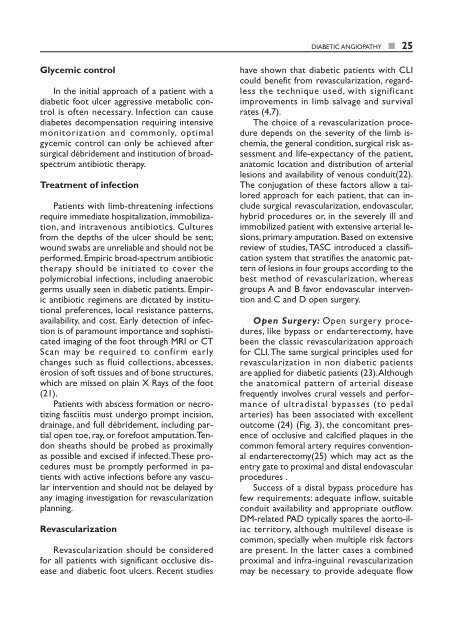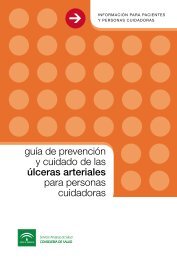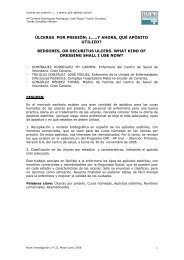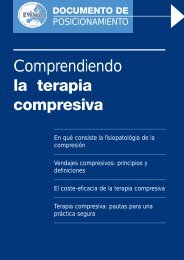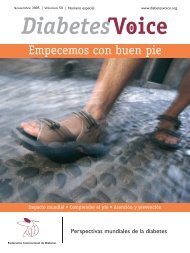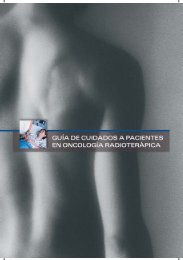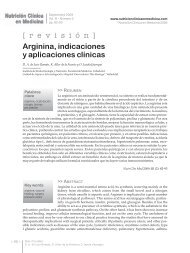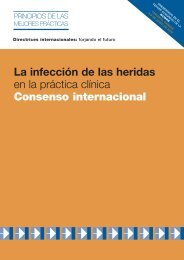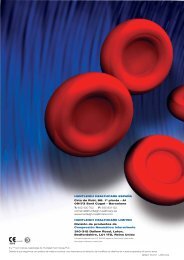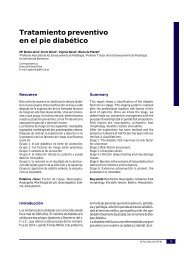Descargar - Úlceras.net
Descargar - Úlceras.net
Descargar - Úlceras.net
- No tags were found...
Create successful ePaper yourself
Turn your PDF publications into a flip-book with our unique Google optimized e-Paper software.
DIABETIC ANGIOPATHY ■ 25Glycemic controlIn the initial approach of a patient with adiabetic foot ulcer aggressive metabolic controlis often necessary. Infection can causediabetes decompensation requiring intensivemonitorization and commonly, optimalgycemic control can only be achieved aftersurgical débridement and institution of broadspectrumantibiotic therapy.Treatment of infectionPatients with limb-threatening infectionsrequire immediate hospitalization, immobilization,and intravenous antibiotics. Culturesfrom the depths of the ulcer should be sent;wound swabs are unreliable and should not beperformed. Empiric broad-spectrum antibiotictherapy should be initiated to cover thepolymicrobial infections, including anaerobicgerms usually seen in diabetic patients. Empiricantibiotic regimens are dictated by institutionalpreferences, local resistance patterns,availability, and cost. Early detection of infectionis of paramount importance and sophisticatedimaging of the foot through MRI or CTScan may be required to confirm earlychanges such as fluid collections, abcesses,erosion of soft tissues and of bone structures,which are missed on plain X Rays of the foot(21).Patients with abscess formation or necrotizingfasciitis must undergo prompt incision,drainage, and full débridement, including partialopen toe, ray, or forefoot amputation. Tendonsheaths should be probed as proximallyas possible and excised if infected. These proceduresmust be promptly performed in patientswith active infections before any vascularintervention and should not be delayed byany imaging investigation for revascularizationplanning.RevascularizationRevascularization should be consideredfor all patients with significant occlusive diseaseand diabetic foot ulcers. Recent studieshave shown that diabetic patients with CLIcould benefit from revascularization, regardlessthe technique used, with significantimprovements in limb salvage and survivalrates (4,7).The choice of a revascularization proceduredepends on the severity of the limb ischemia,the general condition, surgical risk assessmentand life-expectancy of the patient,anatomic location and distribution of arteriallesions and availability of venous conduit(22).The conjugation of these factors allow a tailoredapproach for each patient, that can includesurgical revascularization, endovascular,hybrid procedures or, in the severely ill andimmobilized patient with extensive arterial lesions,primary amputation. Based on extensivereview of studies, TASC introduced a classificationsystem that stratifies the anatomic patternof lesions in four groups according to thebest method of revascularization, whereasgroups A and B favor endovascular interventionand C and D open surgery.Open Surgery: Open surgery procedures,like bypass or endarterectomy, havebeen the classic revascularization approachfor CLI. The same surgical principles used forrevascularization in non diabetic patientsare applied for diabetic patients (23). Althoughthe anatomical pattern of arterial diseasefrequently involves crural vessels and performanceof ultradistal bypasses (to pedalarte ries) has been associated with excellentoutcome (24) (Fig. 3), the concomitant presenceof occlusive and calcified plaques in thecommon femoral artery requires conventionalendarterectomy(25) which may act as theentry gate to proximal and distal endovascularprocedures .Success of a distal bypass procedure hasfew requirements: adequate inflow, suitableconduit availability and appropriate outflow.DM-related PAD typically spares the aorto-iliacterritory, although multilevel disease iscommon, specially when multiple risk factorsare present. In the latter cases a combinedproximal and infra-inguinal revascularizationmay be necessary to provide adequate flow


